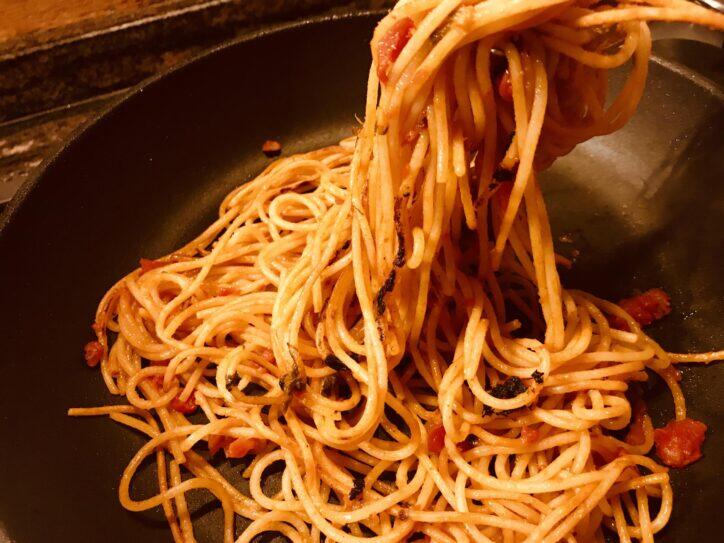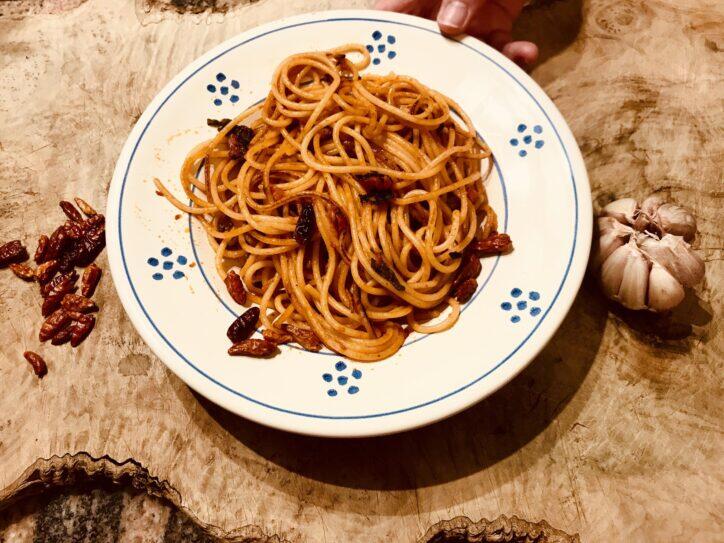Order up a plate of southern Italy’s Assassin Spaghetti—if you dare.
In the south of Italy, people love to indulge in platefuls of a hot and spicy killer pasta that almost chokes them, turning mouths on fire.
Enter spaghetti all’assassina–a.k.a. “assassin spaghetti”–crunchy spaghetti that is fried in tomato sauce, garlic, and the hottest red chili peppers, and then sprinkled with chili powder and more red peppers. They’re so caramelized they appear glossy, shinny, and covered in grease.
Don’t freak-out, the cook won’t murder you. But it will be an intense, passionate food experience you’ll never forget.
The first time I tried the plate was in the spellbinding city of Matera, in deep Basilicata. I was ordering my meal at a local restaurant when my attention was captured by “assassin spaghetti” on the menu. I frowned, looked at the waitress, and suspiciously asked: “What the hell’s this, why the terrible name?”
She simply replied: “Try it and you’ll figure it out. Just make sure to drink water only once you’ve finished it.” As I’m a pretty adventurous eater I ordered the dish.
At a first glance, it didn’t look too good. It was a blotch of bright red, sticky tomato sauce that had a gore-like appearance due to the frying process, resembling clotted blood. The long, crunchy fried spaghetti had been fried to the point of scorching, the darker burnt spots sticking out as if the cook had electrocuted them. Fried bread crumbs had also been showered on top to make the sauce even denser. The spaghetti shape reminded me of the burnt hairs of staked witches (not that I’d ever seen one, but they evoked such an image). It was tough to curl my fork around the spaghetti, the crunchy stiff bits felt like fried bacon in between my teeth.
Recommended Fodor’s Video

But the scent was captivating and the taste spellbinding.
But what the hell, sins of gluttony must be committed once in a while.
I gulped the entire dish down in one minute and felt like my palate was bursting into flames. Instead of drinking water, I ate bread to soothe the burning feeling and ordered another smaller portion.
Assassin spaghetti is a dish to die for: it tests your taste buds (and waistline) and it’s addictive. The oily, greasy tomato sauce that shines on the plate and trickles down the spaghetti isn’t suited for eaters with high blood lipids, who are picky, or calorie-obsessed. It’s not a dish for supermodels. But what the hell, sins of gluttony must be committed once in a while.
It’s pretty clear why it’s called “assassin spaghetti” but I decided nonetheless to embark on a crusade to unearth the deadly origins of such a recipe and why it really bears such a murderous name.
Even though it’s served in many southern towns, its birthplace is Bari, in lovely Puglia. Like all ominous things, it has a mysterious past. It’s a traditionally simple dish that requires a few ingredients and is extremely quick to prepare. Homemakers have been making it for generations, but it appears the exact recipe–and name–are relatively recent and date back to the 1970s.
The legend goes that the owner of a local tavern, Al Sorso Preferito (aka the “preferred sip”), came up with this super spicy concoction when customers from northern Italy, who longed to savor some hardcore, strong southern fare, asked him to bring them what he thought rightfully represents Bari and its foodways.
As it often happens with many great culinary creations, this was spontaneous and prepared by necessity. The chef grasped a few basic ingredients stacked in his cupboards and prepared the peculiar murder plate.
The excited clients dove into the bloody dish, devouring the crispy spaghetti and crunching the scorched parts. Being northern Italians and not accustomed to spicy food but fascinated by the taste, they almost choked. At the end of the meal when the owner came around asking how it was, the satisfied and stunned patrons laughed and shook their heads, telling him it was delicious and jokingly adding, “Man, you’re a killer!”
And so the dish was named “assassin spaghetti” and became popular across the region, drawing queues of diners eager to have a bite of the fiery pasta at the tavern. It’s now an icon, a sacred plate venerated like Bari’s city patron. There’s even an Assassin Academy that zealously promotes what is believed to be the real recipe.
Some of the best places to order it in town are restaurants Al Sorso Preferito (where it all began), Escodirado, Chez Jo, Giampà, and Ai 2 Ghiottoni, where you can try other twists like assassin spaghetti with turnips.
Romans often joke about how such a garlic-imbued delicacy keeps everyone at bay–a “natural” vampire-slayer.
In Rome, there’s a similar, lighter, and plainer “white” gourmet variant without any tomato sauce. It’s called spaghetti aglio, olio e peperoncino–a.k.a. spaghetti fried in garlic, olive oil, and chili peppers. Romans often joke about how such a garlic-imbued delicacy keeps everyone at bay–a “natural” vampire-slayer.
Bari’s assassin spaghetti is nastier than the Roman ones, “more brutal” as Italians would say. It defies healthy eating habits and suits people who have practically been weaned on deadly red chili peppers shaped like little horns and greasy, oily tomato sauces.
What makes it unique is the preparation technique. There are different and opposing versions of how it should be made. Some people in Bari say the pasta must be blanched in boiling water for just two minutes before being poured into a frying pan to be fried with the ingredients; others, like the Academy members, hold that the dry pasta should be added raw directly into the pan without prior boiling, while a few say the spaghetti should be prepared the day before. In fact, another tale on its origins suggests that assassin spaghetti was invented as a clever way to recycle the leftover pasta from the previous evening, which was simply revived by giving it a nice browning. Die-hard food purists in Puglia agree that the best way to prepare and enjoy it is by adopting a topsy-turvy method.
Usually, in all pasta dishes, the dressing is added after the pasta has been boiled to an ideal point–Italians say “al dente,” meaning neither mushy nor hard–but to prepare assassin spaghetti the dry pasta is thrown in the pan at the very end, after the tomato and ingredients have amalgamated, then slowly, boiling water with tomato extract is added at intervals to cook and rehydrate the spaghetti.
Also, traditionalists say the perfect kind of pan is a wide black iron one like those used by their grandmothers that were covered in previously fried oil, burnt at the bottom, and never washed to preserve the scents. In the old days, paper was used to wipe the iron pan. The large width allows the spaghetti to remain intact. However, given that it might be mission impossible to find such an antique item, a regular frying pan is OK and it’s also fine to break the pasta in half (although I’d never do it!), as long as you keep a very high flame.
So here’s how to prepare assassin spaghetti following the “topsy-turvy,” die-hard traditionalist method. And remember: never drink water with it, just chew morsels of bread.
Buon appetito.

Ingredients for Four People: 11 ounces of spaghetti, 1 pound of tomato puree, tomato paste, extra virgin olive oil, garlic, little chili peppers, fresh basil, salt
Time: Just 8-10 minutes!
Steps:
1. Boil a broth with 12 ounces of tomato puree, tomato paste, salt.
2. In a pan, fry 3-4 ounces of olive oil, three garlic cloves, and little chili peppers (the horn-shaped variety) until they brown, then add 4 ounces of tomato puree, spreading it over the pan with a flat wooden spoon.
3. Place the dry, raw spaghetti inside the pan, spreading them out evenly to absorb the sauce. Add the basil leaves.
4. Caramelize the spaghetti until they are glossy before turning them over, regularly adding the broth to hydrate and prevent the pasta from sticking to the pan.
5. Let the sauce sizzle and start to simmer, lightly burning the spaghetti until they’re crispy and slightly stiff. That’s another reason for the name: the spaghetti must be tortured to death for you to fully enjoy it.
*Correction: An earlier version of this article included an incorrect amount of olive oil for the recipe.





Do NOT follow the directions and dump in a liter of olive oil! 4 ounces is about right.
Oh my gosh, thank you! I looked at that and my eyes got so wide, like, that seemed like an excessive amount of olive oil!! LOL